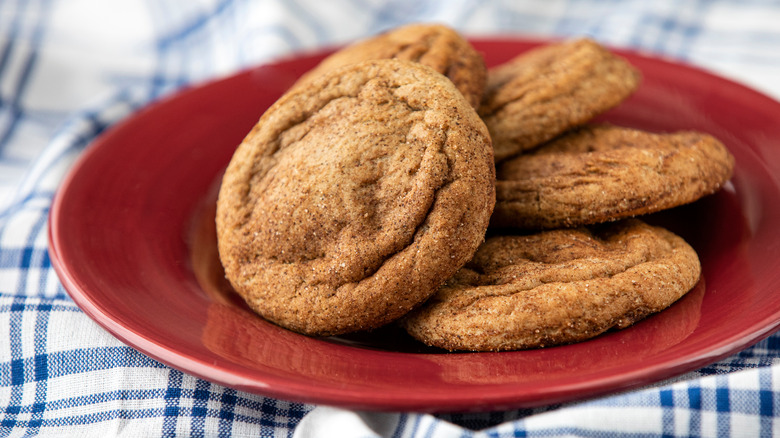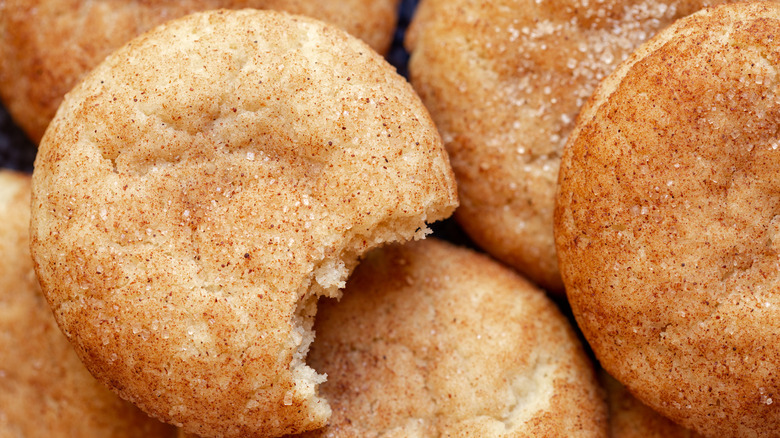Seriously, What's The Actual Flavor Of A Snickerdoodle Cookie?
Whether or not snickerdoodles are the most delicious cookie is a matter of opinion, but they do definitely win the crown for being the cookie with the silliest name. The funniest part is that no one is even entirely sure where the name comes from or what it means, if anything. But suffice it to say, the word "snickerdoodle" doesn't really reveal anything about the cookie itself.
Snickerdoodles are similar to sugar cookies, in that the body of the cookie itself is flavored simply by sugar, butter, and vanilla, but the difference is that they're rolled in a cinnamon-sugar mix on the outside. Sometimes, a bit of cinnamon is added to the dough as well, depending on the recipe. It's a slightly spicier take on the classic, plain sugar cookie, perfect for cold weather but enjoyable at any time of year.
If you're a fan of the warm, cinnamon-sugar flavor combination in the form of cinnamon buns or cinnamon toast (or even Cinnamon Toast Crunch), you're probably going to love snickerdoodle cookies.
A pillowy texture and tangy bite
Because snickerdoodle cookies are rolled in a cinnamon-sugar blend before they bake, something almost like a crust forms on the very exterior of the cookie, giving it not exactly a crunch, but a bit of a toothsome texture. According to some, what really sets a snickerdoodle cookie apart from sugar cookies and other similar cookies is its unique texture: crunchy on the outside, and fluffy on the inside.
Most snickerdoodle recipes call for a mix of baking soda and cream of tartar to help the cookies rise. In addition to working as a leavening agent when combined with baking soda, the cream of tartar prevents the sugar in the dough from crystallizing, so the cookies remain soft and pillowy, as opposed to crunchy or crispy.
The inclusion of cream of tartar has another effect, as well — it creates a tangy flavor, adding a whole other element to the cookie's flavor profile, albeit a subtle one. For a relatively simple cookie recipe with a modest number of ingredients, a good snickerdoodle can really pack in some rich, layered flavor. If you find plain sugar cookies to be a little boring, snickerdoodles might be a game-changer for your cookie repertoire.
What the word snickerdoodle means
If you didn't know what snickerdoodles are supposed to taste like, the name doesn't give you much helpful information. The origin of the "snickerdoodle" name has seemingly been lost to time, but one theory is that they're the creation of 19th-century Dutch-German immigrants to the U.S., and that the name is based on the German word "schneckennudel." This translates literally to "snail noodles," which probably sounds vile to most, but the word actually refers to cinnamon rolls, presumably named after snails for their swirly shape. The cutesy German term, some believe, eventually evolved into the Anglicized "snickerdoodle."
Another viable theory states that "snickerdoodle" is just a made-up word that doesn't mean anything. Some food historians point out that New Englanders have the habit of giving their baked goods intentionally silly-sounding names, evidently just for the fun of it (think whoopie pies, for instance). However the cookies actually got their name, all you need to remember is this one thing: Snickerdoodles are full of cinnamon-sugary goodness.


